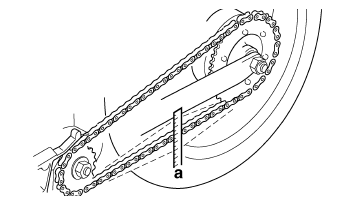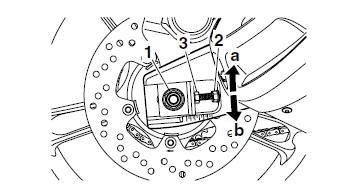Yamaha YZF-R125 Service Manual: Adjusting the drive chain slack
NOTE:
The drive chain slack must be checked at the tightest point on the chain.
| CAUTION: A drive chain that is too tight will overload the engine and other vital parts, and one that is too loose can skip and damage the swingarm or cause an accident. Therefore, keep the drive chain slack within the specified limits. |
1. Stand the vehicle on a level surface.
| WARNING Securely support the vehicle so that there is no danger of it falling over. |
NOTE:
Both wheels should be on the ground without a rider on the vehicle.
2. Turn the rear wheel several times and find the tightest position on the drive chain.
3. Check:
- Drive chain slack "a"
Out of specification
 Adjust.
Adjust.


NOTE:
Measure the drive chain slack halfway between the drive axle and the rear wheel axle.
4. Adjust:
- Drive chain slack
a. Loosen the wheel axle nut "1".
b. Loosen both locknuts "2".
c. Turn both adjusting bolts "3" in direction "a" or
"b" until the specified drive chain slack is obtained.


NOTE:
- To maintain the proper wheel alignment, adjust both sides evenly
- Push the rear wheel forward to make sure there is no clearance between the drive chain pullers and the ends of the adjusting bolts.
d. Tighten the wheel axle nut to specification.

e. Tighten the locknuts to specification.

 Bleeding the hydraulic brake system
Bleeding the hydraulic brake system
WARNINGBleed the hydraulic brake system whenever:
the system is disassembled.
a brake hose is loosened, disconnected or
replaced.
the brake fluid level is very low.
brak ...
 Lubricating the drive chain
Lubricating the drive chain
The drive chain consists of many interacting
parts. If the drive chain is not maintained properly,
it will wear out quickly. Therefore, the drive
chain should be serviced, especially when the
vehi ...
Other materials:
Checking the front fork
The condition and operation of the front
fork must be checked as follows at the
intervals specified in the periodic maintenance
and lubrication chart.
To check the condition
Check the inner tubes for scratches,
damage and excessive oil leakage.
To check the operation
Place the vehicle ...
Disassembling the water pump
1. Remove:
Water pump seal "1"
NOTE:
Remove the water pump seal from the inside of
the water pump housing "2".
2. Remove:
Bearing "1"
NOTE:
Remove the bearing from the outside of the water
pump housing "2".
...
Installing the rear shock absorber assembly
1. Install:
Rear shock absorber assembly
Relay arm "1"
NOTE:
Install the relay arm as shown in the illustration.
2. Tighten:
Rear shock absorber assembly upper nut
Relay arm nut
Rear shock absorber assembly lower nut
3. Install:
Connecting arms
NOTE:
When ins ...
